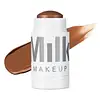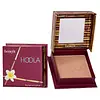What's inside
What's inside
 Key Ingredients
Key Ingredients

 Benefits
Benefits

No benefits
 Concerns
Concerns

 Ingredients Side-by-side
Ingredients Side-by-side

Ricinus Communis Seed Oil
MaskingC12-15 Alkyl Benzoate
AntimicrobialHelianthus Annuus Seed Oil
EmollientHelianthus Annuus Seed Wax
Skin ConditioningCoconut Alkanes
EmollientSilica
AbrasiveEuphorbia Cerifera Wax
Kaolin
AbrasiveMangifera Indica Seed Butter
Skin ConditioningCitrus Aurantium Dulcis Peel Wax
Skin ConditioningPrunus Armeniaca Kernel Oil
MaskingCoco-Caprylate/Caprate
EmollientBis-Stearyl Dimethicone
EmollientParfum
MaskingHydrogenated Vegetable Oil
EmollientIsopropyl Titanium Triisostearate
EmollientTocopheryl Acetate
AntioxidantSorbitan Tristearate
EmulsifyingCI 77891
Cosmetic ColorantIron Oxides
Ricinus Communis Seed Oil, C12-15 Alkyl Benzoate, Helianthus Annuus Seed Oil, Helianthus Annuus Seed Wax, Coconut Alkanes, Silica, Euphorbia Cerifera Wax, Kaolin, Mangifera Indica Seed Butter, Citrus Aurantium Dulcis Peel Wax, Prunus Armeniaca Kernel Oil, Coco-Caprylate/Caprate, Bis-Stearyl Dimethicone, Parfum, Hydrogenated Vegetable Oil, Isopropyl Titanium Triisostearate, Tocopheryl Acetate, Sorbitan Tristearate, CI 77891, Iron Oxides
 Reviews
Reviews

Alternatives
Ingredients Explained
These ingredients are found in both products.
Ingredients higher up in an ingredient list are typically present in a larger amount.
Ci 77891 is a white pigment from Titanium dioxide. It is naturally found in minerals such as rutile and ilmenite.
It's main function is to add a white color to cosmetics. It can also be mixed with other colors to create different shades.
Ci 77891 is commonly found in sunscreens due to its ability to block UV rays.
Learn more about CI 77891This ingredient is a combination of red, black, and yellow iron oxide pigments. This combination of colors is usually found in foundation, because it results in a "skin" color.